Azerbaijan Travel Guide
Welcome to the taste2travel Azerbaijan Travel Guide!
Date Visited: August 2019
Introduction
Located on the shores of the Caspian Sea, at the crosswords of Europe and Asia, the Land of Fire is a country of many contradictions and contrasts.
Neither Europe nor Asia, Azerbaijan is a country of two halves – “the have’s and the have not’s”. While the capital, Baku, offers all the facilities and services you’d expect to find in any cosmopolitan, international city – life in the countryside remains largely unchanged from the slumbering Soviet era.

The lights of Baku Bay – on a slow exposure!
Apart from a brief period of independence in the early 20th century, Azerbaijan spent most of the last 100 years hidden away behind the iron curtain, a composite part of the former Soviet Union. After years of unrest in the outlying republics, the Soviet Union was finally dissolved in 1990. Azerbaijan declared Independence the following year in August of 1991.

A fine example of the craft of ‘Shebeki’, a window pane made of coloured glass and wood, all held together without nails or glue.
Despite being independent, the country remained closed off to the world and very difficult to access. I first tried to visit in 1995, but the visa process was very cumbersome and seemed designed to dissuade visitors. However, in January of 2017, the government, in a bid to increase revenue from tourism, relaxed its visa requirements, allowing 95 nationalities to apply for an e-Visa (see the ‘Visa Requirements‘ section below for more on this).
Today, the country is firmly open and tourists are coming, however the hordes have yet to arrive. As a majority Muslim nation (97%), Azerbaijan is a favoured destination for visitors from the Middle East, most of whom spend their time in Baku shopping, sightseeing and dining. If you escape into the countryside, you’ll often have sights to yourself.
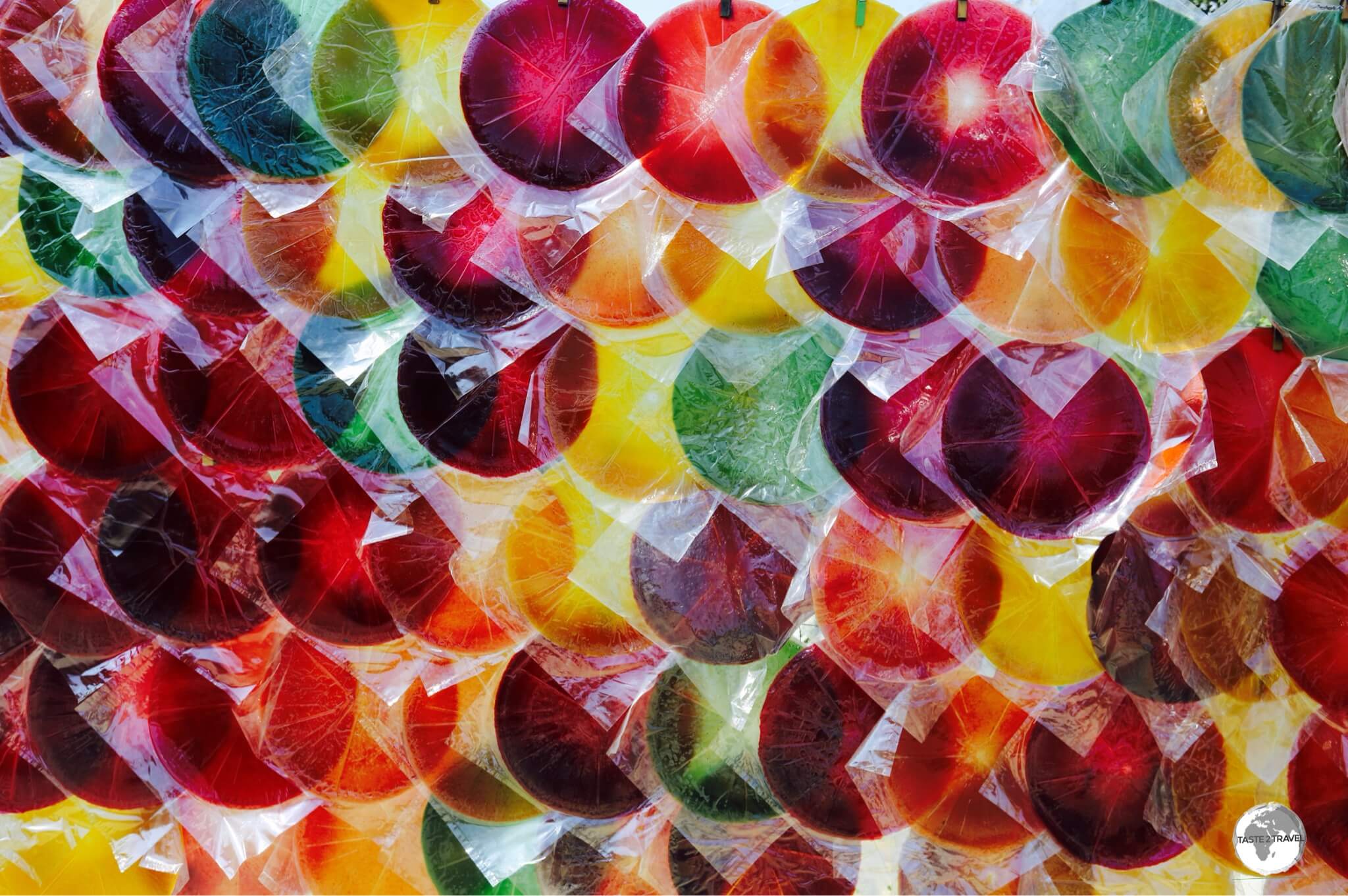
Very colourful Turshu Lavash – a popular snack made from fruits which are cooked into a liquid form, then laid out like pancakes and sun-dried.
In order to raise its international profile, the country hosts a Formula-1 race each year, the Azerbaijan Grand Prix, it recently hosted the 2019 UEFA Europa League Final and, in 2012, it hosted the Euro-vision song contest.
As a destination, Baku has plenty to offer and most visitors to Azerbaijan never leave the capital, apart from a short half-day trip to see the nearby petroglyphs at Gobustan or the mud volcanoes.

Funky artwork and the amazing Zaha Hadid-designed Heydar Aliyev Centre in Baku.
The city has a medieval Islamic core, which is a UNESCO World Heritage site, surrounded by lavish late 19th and early 20th-century European style buildings which grace wide, tree-lined boulevards. These building were built, in the pre-Soviet days, by wealthy landowners who imported whole teams of architects and designers from Paris, and other European cities, to design and build the most ornate residences. Many streets in Baku look like they have been transplanted from Paris. In between these architectural gems, you’ll find equally ornate mosques and other oriental influences.

In November 2010 the Azerbaijani carpet was proclaimed a Masterpiece of Intangible Heritage by UNESCO.
Being an oil producing nation, the country generates significant revenue (about USD$13 billion per year) from oil exports. Much of this has been used to modernise and transform the landscape of Baku, with lots of glitzy show-piece projects à la Dubai. If you spend time driving in Azerbaijan, you’ll realise that all roads lead to Baku, which is a perfect metaphor for the country – it’s all about Baku!

“Nodding Donkey” oil pumps on the outskirts of Baku.
If you wish to visit Azerbaijan, now is the time! This once-slumbering country is awake, and on the move, the bargain-value hotels and restaurants are ready to serve and it won’t be long before the hordes discover this gem on the Caspian.
Republic of Artsakh

A map showing the occupied territory of Nagorno-Karabakh. Source: Wikipedia
As the Soviet Union began to unravel in the mid 1980’s, Azerbaijan entered into a messy and protracted war with neighbouring Armenia over the enclave of Nagorno-Karabakh, a territory of Azerbaijan whose population was mostly ethnic Armenians. The war raged until 1994 at which point Armenia had gained full control of the territory and had expelled the minority Azerbaijani population.
Today, the Republic of Artsakh, as it is known, is unrecognised by most nations, who consider it a part of Azerbaijan. Currently, all borders between Azerbaijan and Armenia / Artsakh are firmly closed.
When entering Azerbaijan, it’s NOT a problem to have Armenian immigration stamps in your passport, but it IS a problem to have Artsakh immigration stamps and you will be denied entry into Azerbaijan. Armenian passport holders are barred from entering Azerbaijan.
Location
Baku, Azerbaijan
Along with Georgia and Armenia, Azerbaijan is one of three countries which comprise the Caucasus region, a region which is situated between the Black sea and the Caspian Sea.
Azerbaijan shares land borders with Turkey, Russia, Iran, Armenia and Georgia. The Caspian Sea forms the entire eastern border of the country.
Nakhchivan
The small Azerbaijani enclave of Nakhchivan is separated from the rest of the country by Armenia. The only way to access Nakhchivan, from Azerbaijan proper, is via one of the regular flights from Baku airport. By land, it’s possible to enter Nakhchivan from Turkey or Iran.
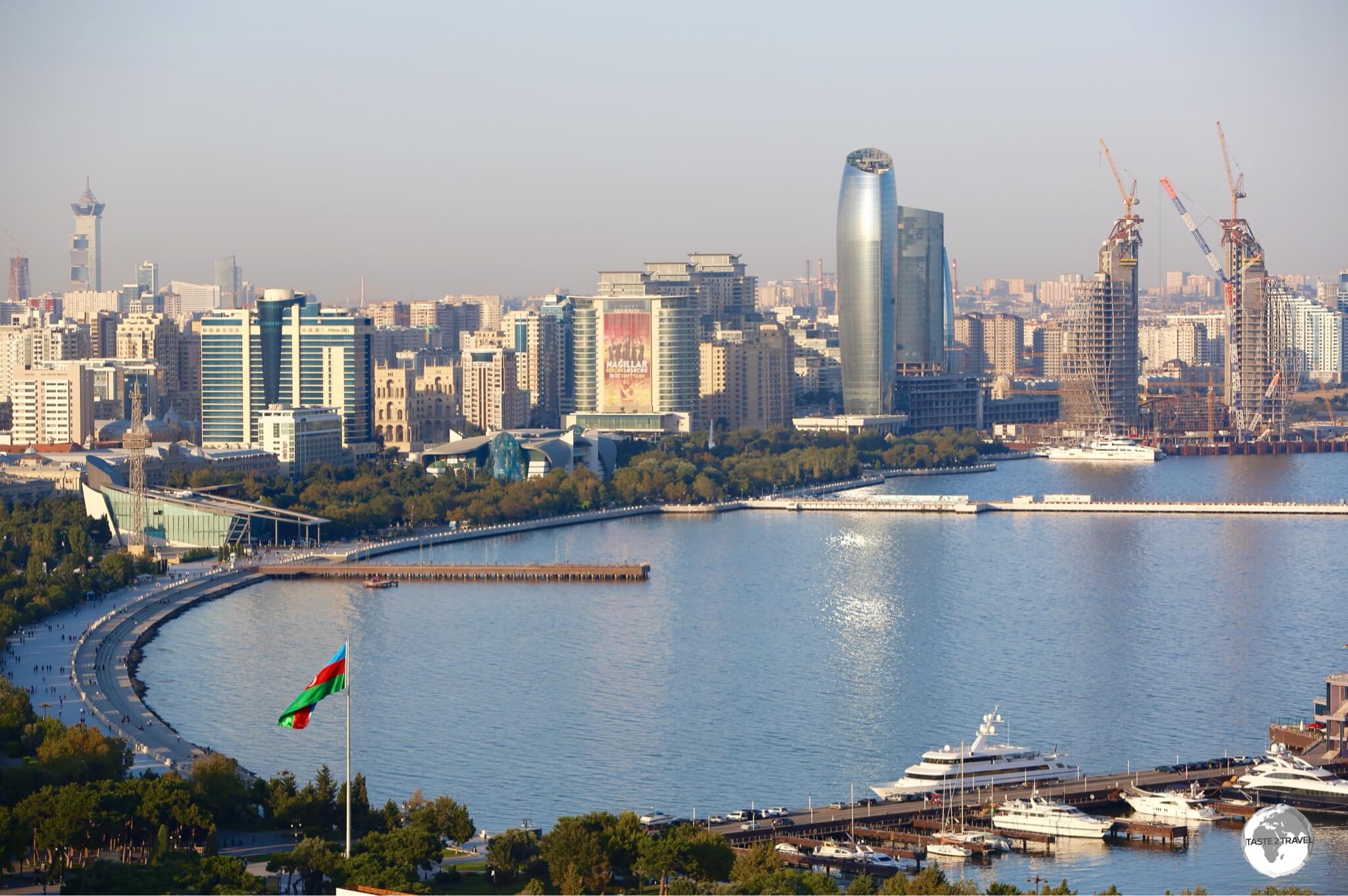
The capital of Azerbaijan, Baku, is situated on the wide Baku Bay.
People
The Azerbaijani diaspora is considerable with large populations living around the world (e.g. an estimated 400,000 live in the United States). Within Azerbaijan, the population is around 10 million, however the largest population (13 million) live south of the border in northern Iran with Azerbaijani’s comprising 25% of Tehran’s population.
The reason so many Azerbaijani’s live in Iran is due to recent history, which saw Russia and Iran divide the former, much larger, territory of Azerbaijan between them, with Russia claiming the northern half and Iran the southern half. The Russian claim included the rich oil fields around Baku, a resource which would be crucial for the Soviet Union. When the Soviet Union collapsed, the northern half claimed independence, while the southern half remains under the control of Iran.
Flag

The flag of Azerbaijan.
The flag of Azerbaijan consists of three horizontal bands of light blue, red, and green which mean:
- Light Blue: symbolises Turkic Multi-nationalism, a movement which was started during the Ottoman empire.
- Red: a symbol for the ongoing development of Azerbaijani culture.
- Green: a symbol of Islam, the pre-dominate religion of the country.
In the centre of the flag is a white crescent moon, another Islamic symbol, and an eight-pointed star which relates to the eight letters in the word “Azerbaijan” as written in Arabic.

A gigantic Azerbaijan flag flying in downtown Baku.
Now that you know a little about the flag of Azerbaijan, you have the answer to at least one of the questions, which you’ll find in my ‘Crescent Flags of the World‘ travel quiz. Good Luck!
Currency

Azerbaijan Manat banknotes were designed by the same person who designed the Euro banknotes.
The currency of Azerbaijan is the Manat (code: AZN/ symbol: ₼) which is derived from Moneta, who was the Roman Goddess of Memory and from which the word ‘Money’ is derived.
The Manat is issued by the Central Bank of Azerbaijan and shares some design similarities with the Euro (€), both having been designed by the same designer, Robert Kalina of Austria.
At the time of my visit, USD$1 = 1.70 AZN – to check the current exchange rate with the USD, click here.
Costs
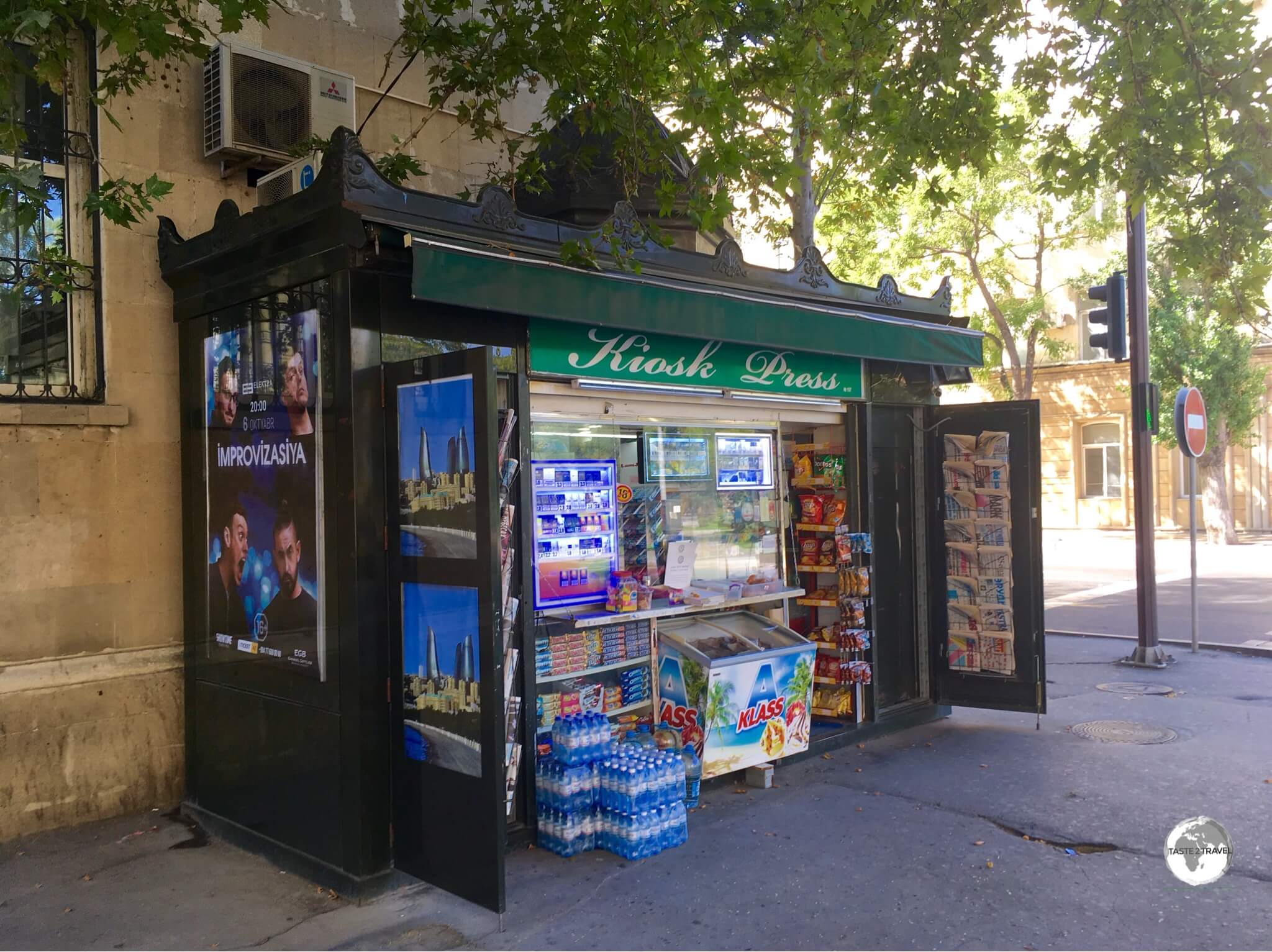
A Parisian-style street kiosk in downtown Baku.
Like other countries in the region, travel costs in Azerbaijan are very reasonable (50% less than what you’d pay in Europe). A cosmopolitan capital, Baku caters for all types of travel budgets with lots of accommodation options, fine restaurants, cafes and glitzy malls.
Suggested daily budgets:
- Backpacker: Up to USD$30 per day.
- Flashpacker: Between USD$60 -$100 per day.
- Visiting Oil Executive: The sky’s the limit.
Sample costs:
- Coca Cola (0.33 litre bottle): 0.80 ₼ (US$0.46)
- Water (0.33 litre bottle): 0.40 ₼ (US$0.23)
- Cappuccino: 4 ₼ (US$2.35)
- Metro Ticket in Baku: 0.30 ₼ (US$0.18)
- Taxi within downtown Baku: 5-10 ₼ (US$3-6)
- Car Rental (daily compact through Hertz): 48 ₼ (US$28)
- Litre of fuel: 0.95 ₼ (US$0.56)
- Combo Meal at McDonald’s in Baku: 8 ₼ (US$4.70)
- Meal (inexpensive restaurant): 10 ₼ (US$5.87)
- Meal for 2 (mid-range restaurant): 40 ₼ (US$23.50)
- Dorm bed in a budget hostel (Kaha Hostel, Baku): 27 ₼ (US$16)
- Room in a mid-range hotel (Radisson Park Inn, Baku): 170 ₼ (US$100)
- Room in a top-end hotel (Four Seasons, Baku ): 600 ₼ (US$350)
Politics

An exhibition at the Heydar Aliyev Centre details the life of the former President.
Azerbaijan became an independent state in 1991, after gaining its sovereignty from Russia. Like other post-Soviet republics, modern Azerbaijan was shaped by one, long-term President, Heydar Aliyev, who served as President from 1993 until his death in 2003.
The regime of Heydar Aliyev has been described as dictatorial, authoritarian, and repressive – typical of all other regimes in the Post-Soviet world. For more of the same politics, you can refer to my Uzbekistan, Tajikistan and Kazakhstan Travel Guides.
Prior to his death, Heydar Aliyev nominated his son, Ilham Aliyev, to be his successor as President, a role which he still occupies. The official results of the October 15, 2003, elections gave victory to Ilham Aliyev, who earned 76.84% of the votes. In all other successive elections, he has won a majority of the votes with 87% in 2008, 85% in 2013 and 86% in 2018 – figures which would be truly stunning in a genuine democracy! In all elections, independent monitors have flagged serious voter irregularities.
Despite the rotten politics, Azerbaijan continues to develop, modernise and move forward, thanks in whole to the annual revenue earned from its oil exports. Because of this, locals are happy to maintain the status quo – for the time being.
Sightseeing

Souvenirs on sale in the old town of Baku.
While most visitors to Azerbaijan don’t leave the capital, or maybe dip their toes into the countryside by venturing 50 km south to Gobustan, there’s plenty to see and do outside of Baku.
Thanks to an ongoing, ambitious, highway building program, getting around the country can be done quickly and efficiently with your own rental car (see the ‘Rental Car‘ section) or by public transport.
For those who like to visit UNESCO World Heritage Sites, there are three in Azerbaijan:
- Gobustan Rock Art Cultural Landscape (2007)
- Historic Centre of Sheki with the Khan’s Palace (2019)
- Walled City of Baku with the Shirvanshah’s Palace and Maiden Tower (2000)
Baku
Heydar Aliyev Centre

The Zaha Hadid-designed Heydar Aliyev Centre is a landmark building in Baku.
Without a doubt, the jaw-droppingly beautiful, and totally original, Heydar Aliyev Centre is the highlight of any visit to Baku. This award-winning, iconic building, was designed by the famous British-Iraqi architect, Zaha Hadid and opened in 2013. Zaha Hadid passed away in 2016, but will forever be known as the “Queen of the curve” thanks to her fluid designs. No straight line was used in the project of the complex.

Curved spaces inside the centre have allowed for the creation of separate exhibition spaces.
Located next to the highway, as you drive in from the airport, this stunning vision in white is impossible to miss – it’s a sight which would impress even the most jaded of traveller.
The centre has become a signature landmark of modern Baku. The interior features eight levels and includes an auditorium (only accessible at performance times to ticket holders), exhibition spaces, a conference hall, workshops and a museum.
For those who are fans of Anish Kapoor, you’ll find one of his ‘reality-bending’ works installed on the ground floor.

Deconstructed Azerbaijani Carpet at the Heydar Aliyev Centre.
While the centre features interesting and engaging displays, the main star of the show is the building itself, which is set on a green hill surrounded by parkland in which giant rabbits graze. It’s all very ‘Instagram-able!
Access: Open every day from 11 am to 7 pm (6 pm on Saturday and Sunday), except Monday. Tickets cost 12 AZN.
Old City

Rugs for sale in the old town of Baku.
Baku grew up around the walled old city, which is known locally as İcheri Sheher. This is one of three World Heritage sites in the country and is believed to date from the 12th century, although some researchers believe it to be much older. Listed on the register in the year 2000, the old city became the first location in Azerbaijan to be classified as a World Heritage Site by UNESCO. The two main sites are the Shirvanshah’s Palace and the Maiden Tower.
Located in the heart of Baku, a short walk from waterfront, İcheri Sheher is an oasis of calm, being surrounded by thick, high stone walls which keep the noise, and most of the traffic, out. It’s a pleasant place to spend time wandering, with many mosques, restaurants, cafes, shops and hotels hidden away in its cobbled lane-ways.
Maiden Tower

The rooftop of the Maiden Tower provides some of the best views in town.
Built in the 12th century, the 29-metre-tall, Maiden Tower, is one of Baku’s most famous landmarks, offering panoramic views of the old city and the waterfront from its rooftop viewing deck. A distinctive feature of the tower is the unusual projecting spine-buttress. The climb to the top leads you through a number of galleries which feature displays on the history of the tower and the old town.
As for the name, the Azeri name for the tower is Qız Qalası, which in English is translated as Maiden’s Tower, however the term most probably refers not to any female maiden but the fact that the tower was never captured (or touched) by invaders.
Access: The Maiden tower is open every day from 9 am to 6 pm. Tickets cost 15 AZN and are sold at the small kiosk opposite the tower entrance.
Museum Centre

The imposing edifice of the Museum Centre, which overlooks Baku bay.
The impressive and imposing Museum Centre, was originally opened in 1955 as the Lenin Museum. Located on the waterfront, this neoclassical building has an imposing facade and contains 4 floors which houses two different museums:
- Museum of Musical Culture: Located on the 2nd floor, this museum features dated and dusty displays detailing the musical heritage of Azerbaijan. Concerts are occasionally organised and CD’s of Azerbaijani folk music are available for purchase.
- Museum of Independence: Located on the 3rd floor, this museum also features old and dated displays which provide an un-engaging political history of the nation.
Access: The Museum Centre is open every day from 9 am to 5 pm. A combination ticket for both museums costs 6 AZN and are sold at the kiosk on the ground floor.

The Azerbaijan Flag at the Museum Centre in Baku.
National Museum of History of Azerbaijan
The National Museum of History of Azerbaijan is located a short walk from the Museum Centre but was closed for renovation at the time of my visit.
Azerbaijan National Museum of Art
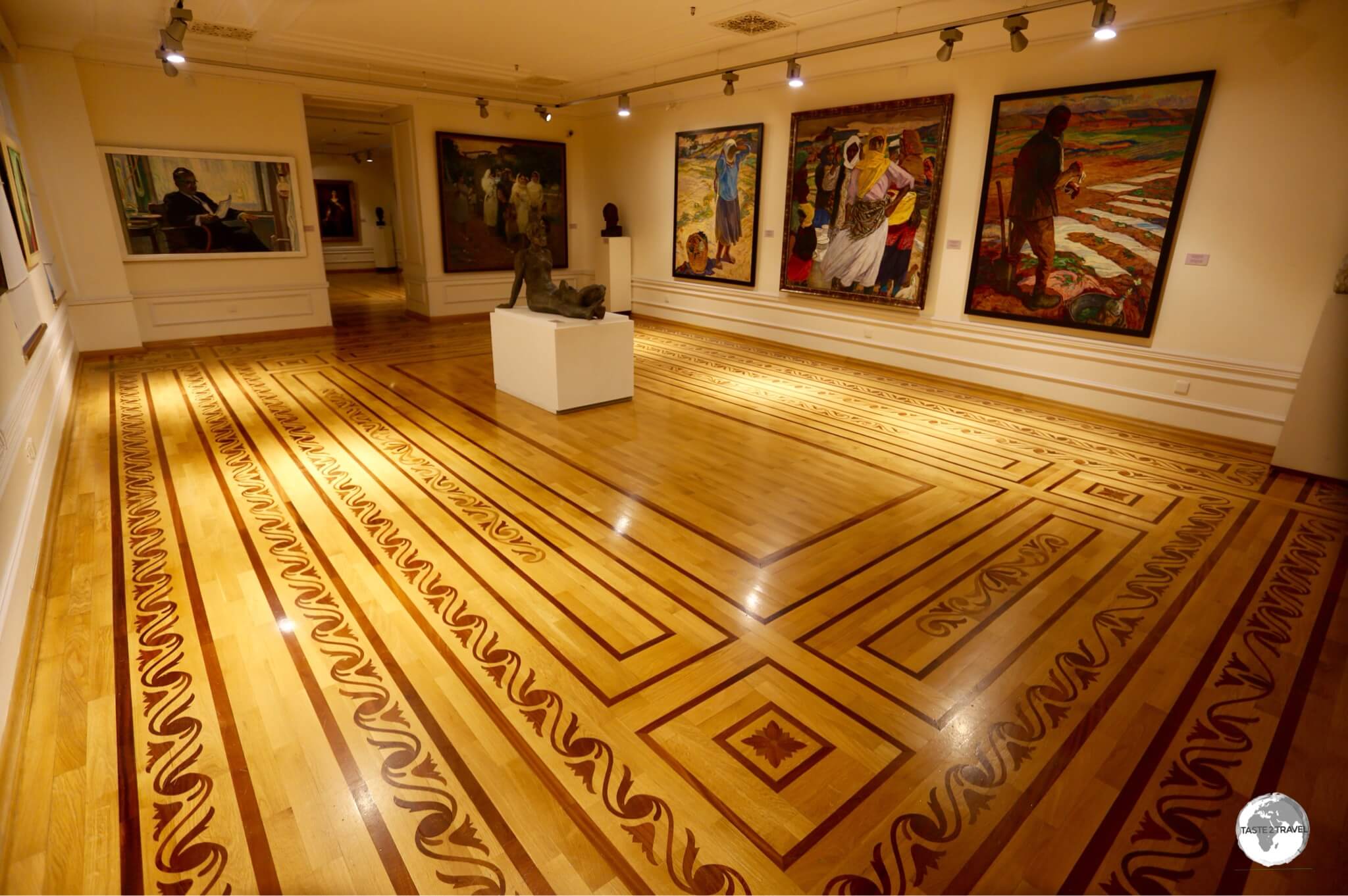
Each of the 60 rooms of the Azerbaijan National Museum of Art feature incredible parquet flooring.
Despite being located downtown, on a busy road, opposite the walls of the Old City, the impressive, and worthwhile, Azerbaijan National Museum of Art is off the tourist radar. During my visit, I was the only visitor. This impressive museum is housed inside two opulent buildings which were built by wealthy oil barons in the 19th century and have since been joined by a glass entrance.
The main building is the lavishly designed – Palace of De Boure – which was originally built by order of Mr Leo De Boure. The museum contains 60 rooms which displays 3,000 different artworks and while I found the displays to be interesting, the highlight for me was the intricate design of the parquet flooring. In each room, the flooring is different, with each piece laid separately to form exquisite floral designs and geometric shapes.
The rooms of the museum contain some incredible works of art which are mostly from Azerbaijani artists. I happily spent 2 hours browsing the exhibits.
Access: The Azerbaijan National Museum of Art is open every day from 10 am to 6 pm, except Monday. Tickets cost 10 AZN with an extra 5 AZN payable if you wish to take photos, which I would recommend.
Azerbaijan National Carpet Museum

The Azerbaijan National Carpet Museum was designed to resemble a rolled carpet.
Located on the waterfront, the Azerbaijan National Carpet Museum houses the largest collection of Azerbaijani carpets in the world. While carpets had, formerly, been displayed in other museums, it was decided to construct a dedicated carpet museum following the 2010 proclamation by UNESCO that Azerbaijani carpets were “a Masterpiece of Intangible Heritage“.
The museum was opened in August of 2014 and was designed to resemble a rolled carpet. While this sounds wonderful from a design point of view, it has made the displaying of carpets, on the curved interior walls, a little difficult.

How to display a flat carpet on a curved wall? Carpets on display at the Carpet Museum.
The museum features an incredible array of carpets from all regions of the country. One of the most interesting exhibits is a hand-woven carpet which features a map of Azerbaijan which is over-laid with examples of different carpet styles typical of each region. A true work of art!

Can you imagine weaving this by hand? An incredible example of weaving.
In addition to traditional carpets, the top floor showcases modern, contemporary designs, some of which are breath-taking. One of my favourites from this collection is pictured below – it’s simply called ‘Rebellion’.

“Rebellion” – one of my favourite carpets in the modern collection of the museum.
It should be noted that if you plan to buy and export an Azerbaijani carpet, you will first need to obtain an export permit (applies to any carpet larger than 1 sq metre). The easiest place to obtain such a permit is from museum carpet shop which is located on the ground floor.
Access: The Azerbaijan National Carpet Museum is open every day from 10 am to 6 pm, except Monday. Tickets cost 7 AZN with an extra 5 AZN payable if you wish to take photos, which I would recommend.
Baku Funicular

The Baku funicular is a nice way to ascend the steep hill to Highland Park.
Located opposite the Carpet Museum, the modern, clean and comfortable Baku funicular whisks you up from near the waterfront to Highland Park in just 3 minutes.
The funicular is the only one of its kind in the country and operates between two stations – the lower “Bahram Gur” and the upper “Martyrs’ Lane”.
Access: The funicular operates between 10:00 and 22:00 with a single ride costing 1 AZN.
Flame Towers

A symbol of a modern and confident city, the Flame Towers dominate the skyline of Baku
Completed in 2012, and befitting of a country which calls itself the ‘Land of Fire’, the three Flame Towers, dominate the Baku city skyline. Located on a hill, overlooking Baku bay, the three towers range in height from 28 to 33 storeys, and are most impressive when viewed from a distance rather than up close.
Once the sun sets the towers come to life, with the facades functioning as large, illuminated display screens thanks to more than 10,000 high-power LED lights. One of the towers is home to the Fairmont Baku hotel while the others are occupied by corporate offices.
Highland Park

The Martyrs’ Lane memorial, Highland Park, Baku.
Located next to the upper funicular station, Highland park offers the best views of Baku and is a great place to watch the sunset over the city and bay. The park features gardens, fountains and a huge balcony which overlooks the city.
One of the most moving monuments in Baku is Martyrs’ Lane, a memorial which is dedicated to those who lost their lives (at the hands of the Soviet Red Army) in one single day – the 20th of January 1990 – during the country’s struggle for independence.

The eternal flame memorial at Highland park, Baku.
The central avenue is lined with a wall of white marble into which polished black marble stones are set with the names of the martyrs. One of the memorial markers (pictured above) features a married couple who were killed together.

The eternal flame memorial at Highland park.
At the end of the avenue, set in a round open plaza, is a large eternal flame.
Baku Eye
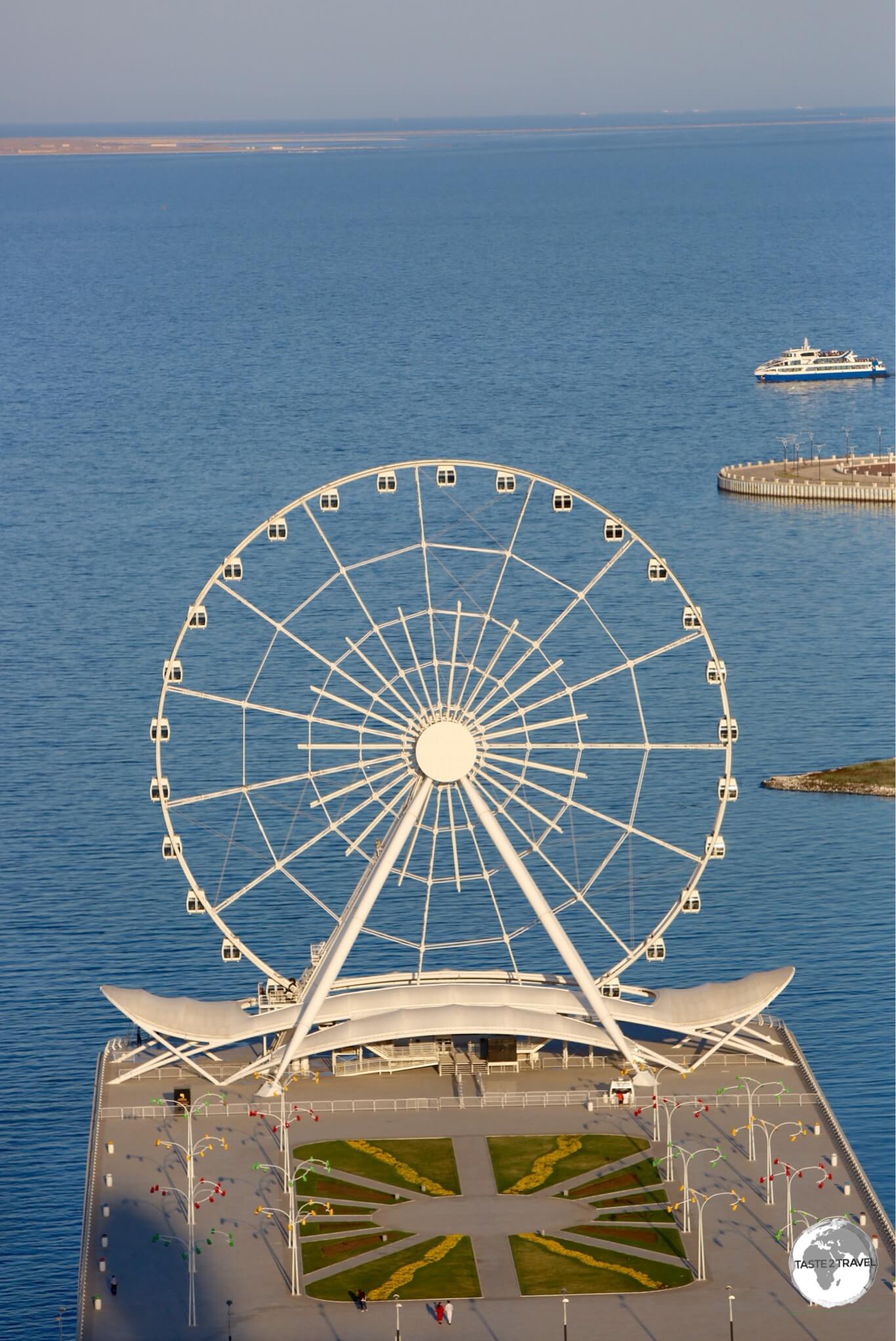
The 60-metre-tall ‘Baku Eye’ Ferris wheel is located on Baku bay.
It seems these days that any city that wants to be taken seriously needs to have their own ‘eye’. Baku Eye is located on the waterfront, a short walk south of the Carpet Museum. This 60-metre-tall Ferris wheel does one revolution every 40 minutes and features large, air-conditioned cabins. George Washington Gale Ferris Jr., who invented the first Ferris wheel for the World Fair in Chicago in 1893, would be proud!
Crystal Hall & National Flag Square
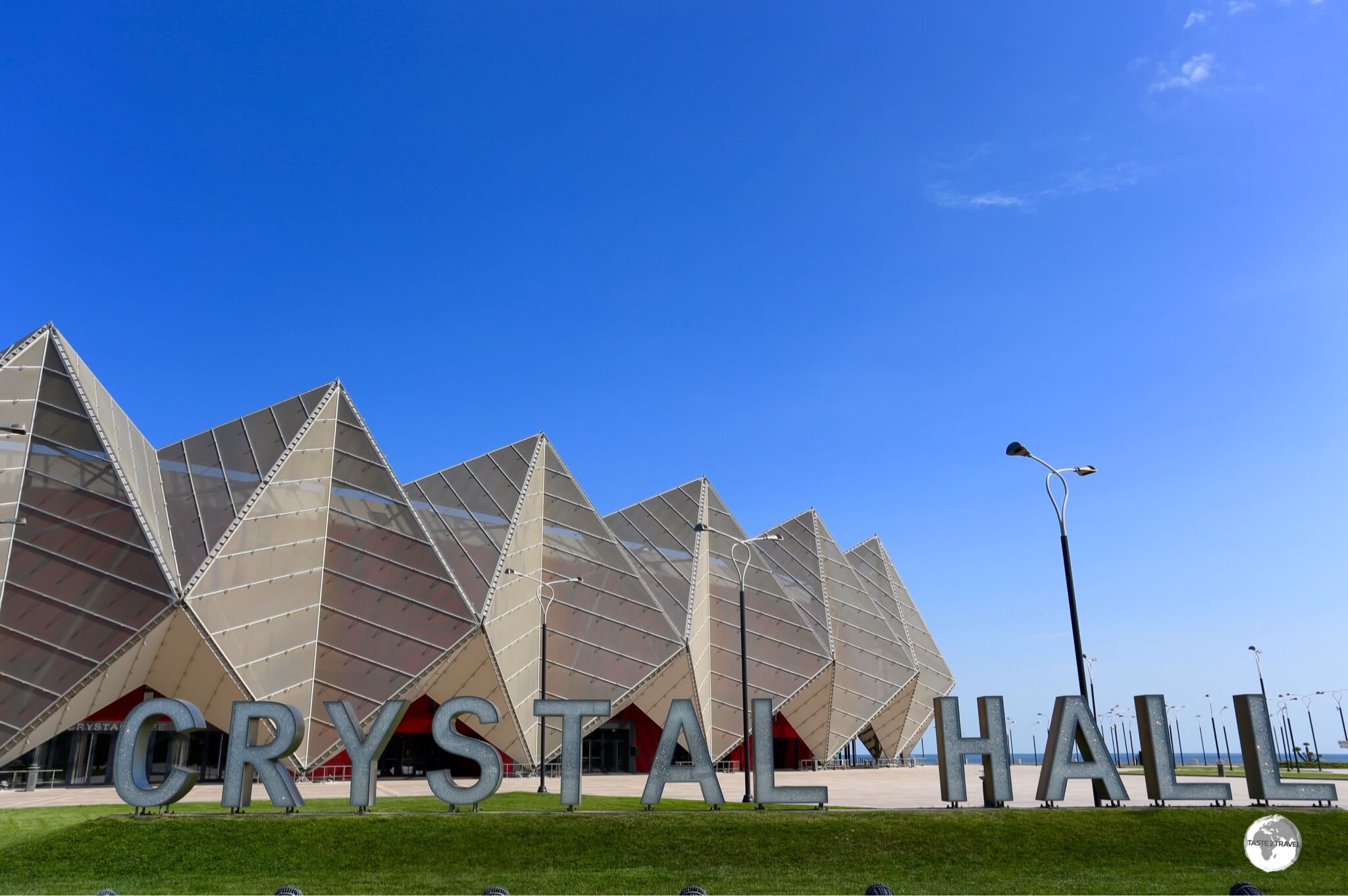
The Crystal hall is located on the waterfront in downtown Baku.
Baku Crystal Hall is a large indoor arena which is located on the waterfront, a short walk south of the Ferris wheel. Built to host the 2012 Eurovision Song Contest, the arena today is used to host concerts and other events.
The hall is only during performances, but the staff at the Crystal Cafe (see the ‘Cafe‘ section below) can organise a sneak peek for paying customers. The coffee and cake at the cafe are divine!
Sharing the same piece of bay side real-estate, the huge raised platform in front of the Crystal Hall is National Flag Square, which is currently without a flag and is closed to visitors.
In September of 2010, the world’s tallest flagpole (then 162 metres) was installed on top of the platform. Then, in the ultimate game of one-upmanship, the government of Tajikistan installed a 165-metre flagpole in Dushanbe! Ouch! You can read all about the Dushanbe flagpole in my Tajikistan Travel Report.
To make matters worse, the same San Diego-based company (Trident Support), who constructed the flagpole in Azerbaijan also built the flagpole in Tajikistan. Then to top everything, the Saudis unveiled a 171-metre flagpole in Jeddah, which still remains the World’s Tallest Flagpole.
As for the Azerbaijan flagpole – rumour is that it will return soon, bigger and better – and most probably taller than 171 metres.
Bibi-Heybat Mosque

The modern incarnation of the Bibi-Heybat Mosque.
Located on the main road, a short distance south of the Crystal Hall, the modern version of the Bibi-Heybat Mosque was constructed in the 1990’s and is a re-creation of the mosque with the same name which was built on the same site in the 13th century. The old mosque was blown up by the Soviets in 1937 ‘for road widening’.
Heydar Mosque
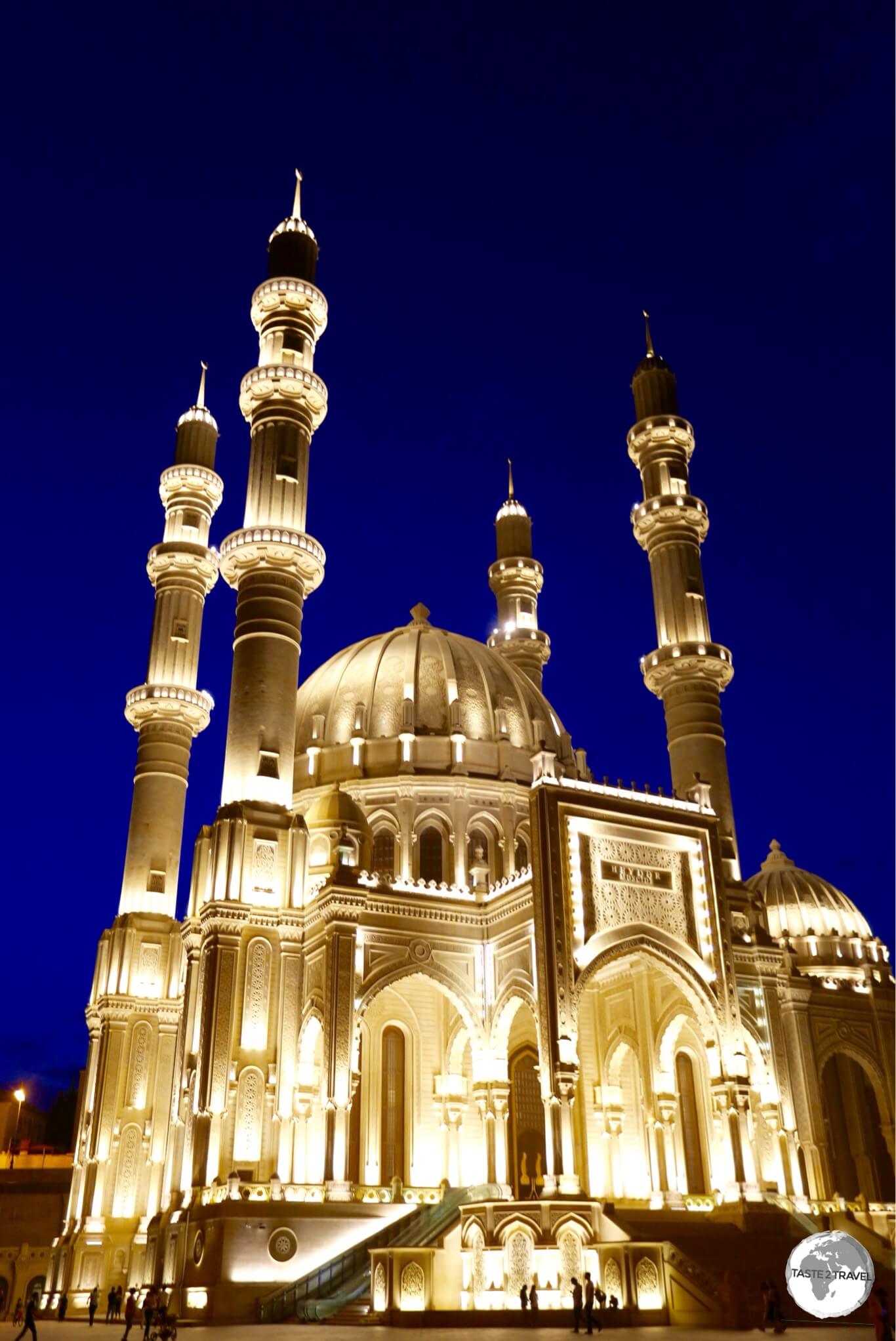
An impressive site, the Heydar Mosque illuminated during the Blue Hour.
Opened in 2014, the Heydar Mosque, is the largest in the Caucasus region. Built in the local Shirvan – Absheron architectural style, the mosque features four 95-metre-high minarets and covers an area of 12,000 square metres.
It’s best to visit the mosque just before sunset so you’re in position to photograph it during the magical ‘blue hour‘ which generally lasts the 20 to 30 minutes just after sunset. The mosque is fully illuminated once the sunsets.
Access: The mosque is located in a non-descript suburb, 8 km inland from the waterfront. I reached the mosque with a taxi which charged me 15 AZN.
Gobustan Petroglyph Reserve

The Gobustan Petroglyph Reserve is set on an escarpment overlooking the Caspian Sea.
Almost all visitors to Azerbaijan spend their time in Baku, however the most popular (half-day), trip out of the capital is to the Gobustan Petroglyph Reserve, which is located 50 km south of Baku on a fast highway.
The site is one of three UNESCO world Heritage sites in Azerbaijan and attracts hordes of tour groups. Set on an escarpment overlooking the Caspian Sea, a few kilometres inland from the coastal highway, the petroglyphs were first discovered by a local miner in 1939-40 and are believed to be 40,000 years old.

A prehistoric version of the “Family Diagram” bumper sticker!
The rock art represents flora and fauna, hunting, lifestyles, and culture of pre-historic with many of the petroglyphs well worn by the ravages of time. An easy way to find them is to look for the newly engraved serial numbers which have been carved into the rock near to the drawings.
It’s believed that the drawings were originally carved inside caves which early man inhabited, but over time, the caves have collapsed, leaving the former walls now exposed to the elements. While the drawings are fascinating, the sweeping views from the escarpment are just as engaging.
A visit to the complex starts 3 km down the road at the visitors centre which outlines the history of the complex. The ticket office is located in a booth outside the visitors centre.
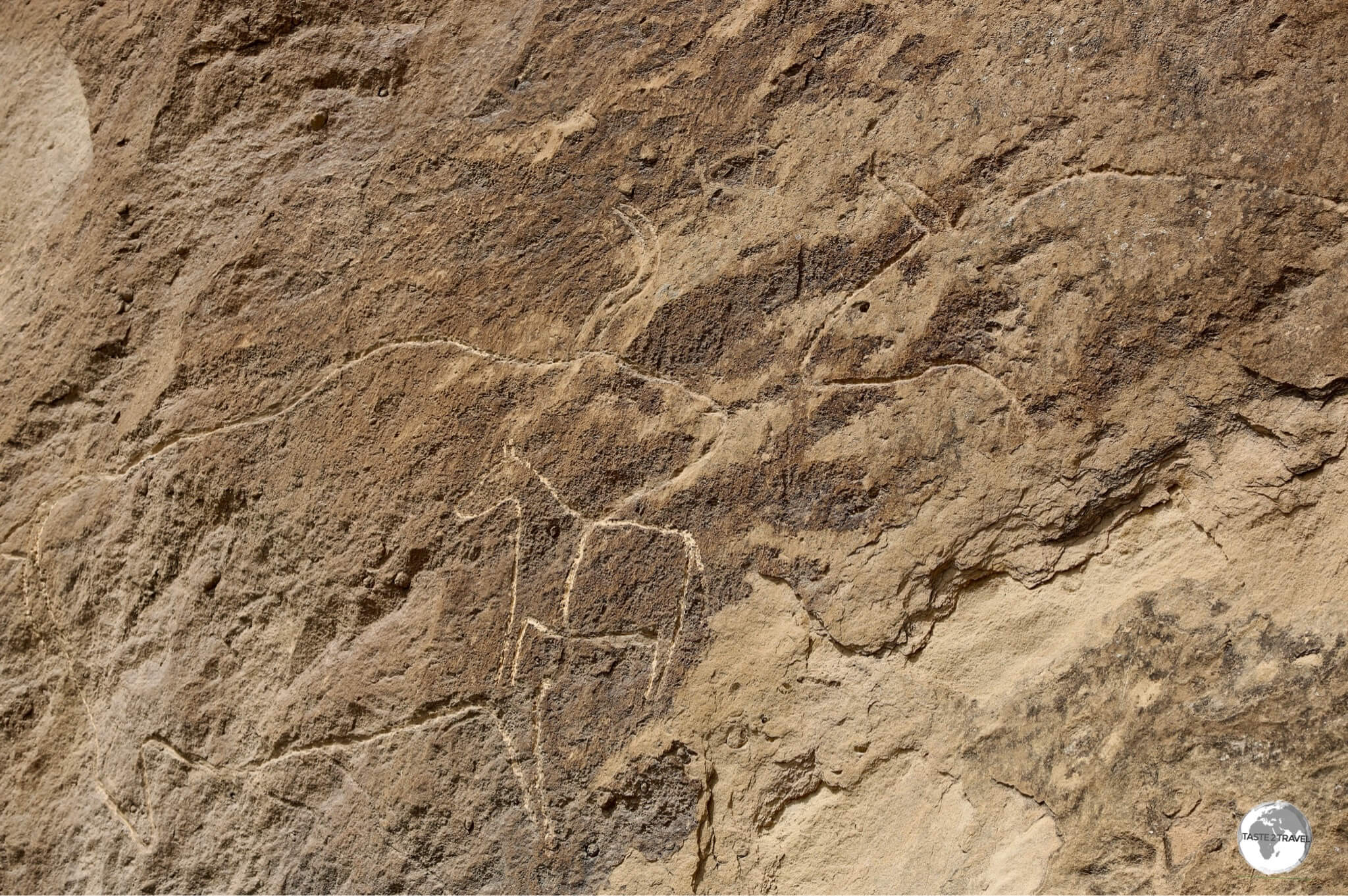
The petroglyphs of Gobustan feature diagrams representing flora and fauna.
Access: The reserve is open every day from 9:00 am to 5:00 pm with tickets for foreigners costing 10 AZN. You can check all ticket and tour prices here.
I drove my rental car which took me about 45 minutes from downtown Baku along the fast coastal highway. If you don’t have transport, there are plenty of affordable day tours (80 AZN) from Baku which also include additional sites, such as the Mud volcanoes. If you really wish to attempt public transport, bus #195 from Baku stops at the southern end of Gobustan from where taxi drivers wait to take you to the visitors centre and the reserve.
Mud Volcanoes

One of many mud volcanoes which can be seen at Daşgil Hill.
Located 20 km down the road from the petroglyphs, on top of the utterly remote and bleak Daşgil Hill is a weird collection of baby mud volcanoes.
The access road to the site is a very poor, rough, gravel road which is un-signposted. I reached the site in my rental car using Google Maps, which led the way, although I thought Google was leading me astray until came across a group of strange conical mounds that were gurgling and spitting cold, wet, grey, mud.

The mud from the volcanoes is cool rather than hot and slowly gurgles its way to the surface.
The poor accessibility of the site means that the tour buses are unable to visit, which offers some respite after dealing with the masses at Gobustan.
There are an estimated 800 mud volcanoes in the world, with Azerbaijan containing the largest collection with 300 – there are at least 20 at this site.
Rich oil and gas fields are always found in the vicinity of mud volcanoes and nearby, one oil seep can be viewed near to the mud volcanoes. A seep is the result of oil flowing to the surface through faults in the earth’s crust.

An oil seep near to the mud volcanoes.
Access: Due to its remote location, there’s no ticket office, no visitor centre or any other infrastructure. The site is completely open and can be visited at any time.
Quba
Located in the north of Azerbaijan, in the foothills of the Caucasus mountain range, a short drive from the Russian Republic of Dagestan, Quba is famous for its apples which are the sweetest apples you’ll ever taste. As you approach town, the frequency of apple sellers along the highway increases. Apples are sold by the bucket and so, when I stopped at one stall and asked for a measly two apples, the kind old lady simply handed them to me and refused payment. I insisted on giving something so I left her with a nice tip!
Quba is a popular getaway in itself but more particularly a gateway to the villages in the Caucasus mountains. The town is sleepy and quiet but is home to one important site – the Quba Genocide Memorial Complex.
Quba Genocide Memorial Complex

The striking Quba Genocide Memorial Complex is located on the outskirts of town.
The complex, which sits on the grounds of a former sports field, was constructed following the discovery of a mass burial site in 2007, which was unearthed by construction works. The striking site features two large concrete pyramids which rise dramatically above a subterranean museum. Surrounding the pyramids is an apple orchard, a memorial marking the location of the burial site and a flagpole.

My apple which was carefully selected from the orchard by my friendly guide. It tasted so good!
You must be accompanied by a guide while inside the museum, which is included in the ticket price. Prior to entering the museum, I asked my guide about the apples which were hanging on the trees and looked very tempting. He carefully selected the best one for me and I can attest, it was the most superb tasting apple.

The interior of the subterranean museum at the Quba Genocide Memorial.
The memorial commemorates the massacres of April and May 1918, when Armenian (Christian) Bolshevik forces invaded the area and massacred some 16,780 civilians, almost all Muslim and some local Jews. Many of those killed were buried in the mass grave. The museum displays, which are moving and engaging, provides information on the history of the region and the events during the time of the Armenian invasion.
Access: The complex is open every day from 9:00 am to 6:00 pm with tickets for foreigners costing 10 AZN. The complex is located on the western outskirts of town.
Çuxur Hamam

The ancient Çuxur Hamam in Quba.
Apart from the Genocide complex, one other site in town is the Çuxur Hamam. When I arrived (around 4 pm), the museum was closed. I was able to access the roof from where I took this photo.
Sheki
Located 300 km northwest of Baku, the popular tourist destination of Sheki is located on the slopes of the Caucasus mountain range, close to the border with Georgia. Sheki is considered to be the loveliest town in Azerbaijan, and was once a residence for the ruling Sheki Khans. The town has one of the greatest densities of cultural resources and monuments in Azerbaijan which include 2700 years of Azerbaijani history.
Sheki was once an important stopover point on the Silk Road and today several caravansaries still exist in the old town, one of which has been converted into a hotel and is open to visitors.
Palace of Sheki Khans

The exterior of the Palace of the Sheki Khans – photos are not allowed inside.
The main attraction in town is the hilltop Palace of the Sheki Khans which was once a summer residence for the Khans and is one of three UNESCO World Heritage site in Azerbaijan.
The palace was built in 1762 by Huseyn Khan and sits among huge Chinar trees within the fortress complex. Every available inch of the palace interior is covered in the most ornate artwork and features vivid murals and dazzling coloured light streaming through Shebeki windows (see the following section). The windows in the palace are the best examples of Shebeki that exist anywhere.
The exquisite interior is a photographer’s dream, however photos are only allowed if you purchase a 300 AZN (USD$175) photography license.

The wall of the Sheki arts and craft centre features locally made ceramic artwork.
Access: The Palace is open every day from 10:00 am to 6:00 pm with tickets for foreigners costing 10 AZN. The fortress complex is a short walk uphill from the old town.
Shebeki
Unique to Azerbaijan, Shebeki (stained-glass windows) can be viewed in all their colourful glory at the Palace of the Sheki Khans. If, like me, you fall in love with these amazing creations, you can see how they are made at a workshop which is inside the craft centre by the main entrance to the fortress complex.
Here an expert craftsman will show you how the panels are made which is:
- Step 1: Cut a piece of coloured glass to fit the panel section.
- Step 2: Cut a piece of wood to act as a frame for the glass piece.
- Step 3: Insert the glass piece into the larger panel.
- Step 4: Insert the supporting wooden retainer which will hold the glass in place.
- Step 5: Repeat all of the above steps until you have finished your panel, then enclose all the pieces in a wooden frame. No nails, no glue.
The following photos illustrate the process.

Step 1: Cutting the glass.

Step 3: Insert the glass piece into the larger panel.

Step 4: Insert the supporting wooden retainer which will hold the glass in place.

Step 5: Enclose all the pieces inside a wooden frame. No nails, no glue.
Caravansary

The courtyard of the old caravansary, which today is welcoming a new type of guest.
Once a Silk Road caravansary, this impressive building has been renovated and converted into the Karavansarai Hotel. Even if you’re not staying here, you are free to visit and photograph the beautiful courtyard. The best coffee in town can be found at the Illy Cafe (see the ‘Cafe‘ section below), which is located outside on the main road.
Caravansaries once served as ancient roadside inns, where travellers could rest and recover from the day’s journey. They supported the flow of commerce, information and people across the network of trade routes covering Asia, North Africa and Southeast Europe, most notably the Silk Road.
Accommodation
Like everything else in Azerbaijan, visitors are spoilt for choice when it comes to accommodation options in Baku. However, elsewhere, while options exist, they are more limited.
Baku

My room at the Radisson Park Inn, Baku.
My room at the Radisson Park Inn in Baku.While in Baku, I stayed downtown at the excellent Radisson Park Inn, where rooms cost around US$100 per night, although sometimes cheaper if booked through an OTA such as Booking.com or Hotels.com.
The reason I selected the Park Inn was that, at the time of making my reservation, I was staying in Tashkent at the excellent Tashkent Radisson Blu hotel, which is included in my Uzbekistan Travel Guide. I simply wanted to soak up more Radisson hospitality!
The Park Inn is centrally located on the waterfront, opposite the Park Bulvar mall, which offers plenty of dining and shopping options. Everything of interest in Baku is within walking distance of the hotel.
Quba

Kvartira – my wonderful apartment in Quba.
The northern city of Quba has limited accommodation options, however I found a gem! I booked an amazing apartment, Kvartira, through booking.com, which cost me US$50 per night which is about average in the provinces.
My spacious, clean apartment included a washing machine (always appreciated!), a kitchen, cable TV and two large bedrooms which could easily accommodate the Brady Bunch, should they ever come to town.
The apartments are located on the 1st floor of a non-descript, modern building in a non-descript side street of Quba. The building has no signage suggesting that there are rental apartments in the building and Google maps couldn’t locate the address. I had to phone the owner who directed me to the premises. It’s all very, well, non-descript but the apartment is wonderful, especially if you need to do some laundry.
The owner is very enthusiastic and helpful and speaks a little English. Due to the location, it’s best suited to people who have their own transport.
Sheki

My comfortable room at the Sheki Saray hotel in Sheki.
Having once accommodated the Khans of Sheki, this popular tourist town offers plenty of good accommodation options, catering to all budgets.
I stayed at the very good, Sheki Saray hotel which is located in the heart of the downtown area and offers comfortable rooms from US$65 per night. It’s always nice, while in town, to be able to leave the rental car parked in the hotel car park while you explore on foot. Everything of interest is a short walk from the hotel.
Eating Out

A typical meal in Azerbaijan – BBQ’d meat, salad, bread and some rice.
As with accommodation, and everything else, when it comes to dining options, visitors are spoilt for choice in Baku. However, elsewhere, options are far more limited and normally restricted to ‘national’ cuisine which is best illustrated in the photo above.

Qutab is a popular snack in Azerbaijan which is grilled flatbread stuffed with cheese and herbs. The same as Turkish Gözleme!
The cuisine of Azerbaijan is typical of the region, with an emphasis on kebabs, BBQ’d meat, salads and bread – all washed down with pots of black tea. If you’re arriving in the country from any of the neighbouring countries, or Central Asia, the cuisine of Azerbaijan will be very familiar to you. However, in Baku, you have a great variety of international cuisines available, plus all the regular fast food chains, coffee houses etc.
Restaurants

A delicious meal at a roadside restaurant on the road to Sheki.
Baku

Colourful food trucks can be found throughout the downtown area of Baku.
While in Baku, I took advantage of the variety of cuisines to take a break from the daily diet of shashlik, salad and bread to instead enjoy some fiery Indian, tasty Chinese and deliziosa Italian!
If you’re craving Italian, the global franchise, Vapiano, (actually a German company) have opened a new branch of their amazing casual dining restaurant in Baku, opposite one of the best cafes in town, the Baku Book Centre (see the ‘Cafe‘ section below for more on BBC).
Both the 28 mall, which is located opposite the main train station, and the Park Bulvar mall, which is located on the waterfront opposite the Park Inn hotel, offer a good variety of dining options and coffee chains. If you’re craving fast food, Starbucks, or the Australian chain – Gloria Jean’s Coffees, these malls are your best bet.
Quba
There are limited dining options in Quba with almost all specialising in ‘national’ cuisine. Most restaurants outside of Baku offer al-fresco dining, which is wonderful on a starry night.
While in town, I ate at the Palma restaurant which is located on Molla Pənah Vaqif Küçəsi – a short walk from Kvartira apartments. The speciality of the restaurant is shashlik, the most amazing, fresh salads and freshly baked bread.
Sheki
Being the main tourist draw-card outside of Baku, Sheki offers plenty of dining options. I ate at the popular Restoran Çələbi Xan which is conveniently located opposite the Sheki Saray hotel. The menu features BBQ’d meats, salads, soups and is a good place to try Sheki baklava, which is best washed down with an espresso from their Italian coffee machine.
Cafés

A great place to chill and enjoy a delicious coffee – Baku Book Centre Cafe.
Baku

Cafe Latte at the Baku Book Centre Cafe.
Caffeine addicts are totally spoilt for choice in Baku! I did my best to sample a multitude of cafes, and would nominate Bliss Cafe as one of my favourites. The cafe is located around the corner from the Hilton hotel at #3 Azadliq Ave. The cafe offers one of the few breakfast menus in Baku, with an emphasis on healthy options, low on fat and sugar. The porridge is amazing as are the poached eggs.
Another favourite cafe is the very hip and stylish cafe at the Baku Book Centre (BBC) which is located opposite Vapiano and the lively Molokan Gardens. This spacious cafe features funky artworks, great coffee and tasty food.

Creative artwork on the wall of the BBC Cafe.
Another worthwhile cafe is the Crystal Cafe, which is located inside the Crystal Hall. The cheesecake (pictured above), was served to me on one of my visits along with an excellent flat white. If you wish to view the Crystal Hall (which is always closed accept during performances), the friendly staff can escort you to the auditorium for a sneak peak, but photography is not allowed.

An amazing cheesecake, served at the Crystal cafe at the Crystal Hall in Baku.
Quba
There are no good cafes in Quba. If you really need a caffeine fix, the best option is to drive back to Baku, a drive of 159 km (99 mi)!
Sheki
There are a few cafes in Sheki which are equipped with an Italian espresso machine. The Illy Espresso House, which is part of the Karvansaray hotel complex, offers the best coffee in town. The Restoran Çələbi Xan also offers decent Italian espresso coffee as does the Sheki Saray hotel.
Bars

The national beer of Azerbaijan, Xirdalan, is very smooth on the palette.
Despite being a predominately Muslim country, alcohol is readily available in Azerbaijan, a legacy of years spent in the Soviet Union where religion was banned and alcohol consumption was an integral part of the culture.
A product of Carlsberg, the light and very quaffable, Xirdalan, is the most popular beer in Azerbaijan, and can be found in most restaurants throughout the country. While dedicated bars can only be found inside top-end hotels, most restaurants serve alcohol.
Visa Requirements

Azerbaijan passport stamps.
In January of 2017, Azerbaijan significantly relaxed its visa requirements for 95 different nationalities, who are able to apply for a 30-day e-Visa. The system is called ASAN Visa and has been recognised as one of the easiest e-visa processes in the world.

My Azerbaijan e-Visa.
The application process is simple and quick, with a payment of USD$23 (USD$20 + USD$3 service fee) required. Visas are issued via email within 3 working days. The visa needs to be printed and presented upon arrival. You can apply for the visa at the ASAN Visa website.
To check your requirements, please refer to the Visa Policy of Azerbaijan.
Getting There

Buta Airways at Heydar Aliyev International Airport.
Air
There are six international airports in Azerbaijan, with the main one being Heydar Aliyev International Airport in Baku. The airport is located 20 kilometres northeast of Baku, and is connected to the city by a modern highway. The airport serves as the base for the national carrier, Azerbaijan Airlines, and its low-cost subsidiary Buta Airways.
The following airlines provide scheduled services to/ from Heydar Aliyev International Airport:
- Aeroflot – flies to/ from Moscow–Sheremetyevo
- Air Arabia – flies to/ from Sharjah
- Air Astana – flies to/ from Almaty, Nur-Sultan
- Al Naser Wings Airlines – flies to/ from Erbil
- Azerbaijan Airlines – flies to/ from Almaty, Ankara, Beijing–Capital, Berlin–Tegel, Delhi, Dubai–International, Erbil, Ganja, Geneva, Istanbul, Kiev–Boryspil, Kuwait, London–Heathrow, Milan–Malpensa, Moscow–Domodedovo, Moscow–Vnukovo, Nakhchivan, New York–JFK, Paris–Charles de Gaulle, St Petersburg, Tashkent, Tel Aviv
- Belavia – flies to/ from Minsk
- Buta Airways – flies to/ from Ankara, Astrakhan, Batumi , Dammam, Istanbul–Sabiha Gökçen, Izmir, Kazan, Kharkiv, Kiev-Zhuliany, Mineralnye Vody, Moscow–Vnukovo, Odessa, Riyadh, St. Petersburg, Tbilisi, Tehran–Imam Khomeini, Ufa
- China Southern Airlines – flies to/ from ÜrümqiEtihad Airways – flies to/ from Abu Dhabi
flydubai – flies to/ from Dubai–International - Gulf Air – flies to/ from Bahrain
- IrAero – flies to/ from Chelyabinsk, Orenburg, Rostov-on-Don
- Iran Air – flies to/ from Tabriz, Tehran–Imam Khomeini
- Iraqi Airways – flies to/ from Baghdad, Erbil, Sulaymaniyah
- Jazeera Airways – flies to/ from Kuwait
- Kuwait Airways – flies to/ from Kuwait
- Lufthansa – flies to/ from Frankfurt
- Mahan Air – flies to/ from Tehran–Imam Khomeini
- NordStar – flies to/ from Samara, Ufa
- Pegasus Airlines – flies to/ from Ankara, Izmir
- Qatar Airways – flies to/ from Doha
- S7 Airlines – flies to/ from Novosibirsk
- SCAT Airlines – flies to/ from Aktau
- Smartavia – flies to/ from St Petersburg
- Turkish Airlines – flies to/ from Ankara, Istanbul
- Ukraine International Airlines – flies to/ from Kiev–Boryspil
- Ural Airlines – flies to/ from Samara, Yekaterinburg
- Utair – flies to/ from Moscow–Vnukovo, Surgut
- Uzbekistan Airways – flies to/ from Tashkent
- Wizz Air – flies to/ from Budapest
Airport Transport
Taxi: A regular metered London Baku taxi to downtown will cost between 20-25 AZN with a journey time of 25-45 mins, depending on (usually heavy) traffic.
Bus: The public bus company, Baku Bus, operates an express airport shuttle (route H1), 24-hours a day, which departs every 30 minutes from 06:00 to midnight and every hour between midnight and 06:00. The shuttle runs between the airport and 28 May metro stop which is near the main railway station.
In order to use the bus, you’ll first need to purchase a stored-value BakuCard from the kiosk in the arrivals hall, as you cannot buy tickets on the bus. A single ride on the bus costs 1.30 AZN (USD$0.75) plus 2 AZN for the card, which is non-refundable.
Land

Map of Azerbaijan. Source: https://www.nationsonline.org
It’s possible to enter Azerbaijan overland from Russia, Iran, Georgia and Turkey (only Nakhchivan). Due to the ongoing dispute with Armenia over Nagorno-Karabakh, all land borders between the two countries are closed.
A description of all land borders:
- Georgia: situated to the west of Azerbaijan, shares a land border of 428 km (265 mi) which includes two international crossings.
- Russia: situated to the north of Azerbaijan, shares a land border of 338 km (210 mi) which includes three international crossings and one crossing for locals only (Garax-Zukhul).
- Iran: situated to the south of Azerbaijan, shares a land border of 1,132 km (703 mi) with Azerbaijan proper and 429 km (266 mi) with Nakhchivan. There is a total of two international crossings with Azerbaijan proper and one crossing with Nakhchivan at Culfa.
- Turkey: shares a very short, 17 km (10 mi), border with Nakhchivan with one international crossing.
Rail

The historic Baku Central Train Station.
Azerbaijan is connected by rail to Russia, Georgia and Ukraine (via Russia). There’s a rail connection with Armenia but this is presently closed due to the ongoing dispute over Nagorno-Karabakh. The governments of Iran and Azerbaijan are currently working on connecting the two countries by rail. There was a rail service which connected Nakhchivan with Iran, but this has, apparently, been terminated.

The interior of the glitzy and sparkling clean main hall of Baku Central Station.
Tickets for international trains departing from Baku station can be purchased from the international ticket desk at the main station.
The following International services depart from Baku station:
- Russia: Train #55 leaves Baku every Thursday at 01:30 for the 53-hour odyssey north to Moscow–Kursky, arriving two days later at 03:20 in the morning. The cheapest online ticket on this service costs 183 AZN (USD$107).
- Georgia: Train #38 departs Baku each evening at 20:40, arriving in Tbilisi the following morning at 08:55, a journey of 12 hours. If you wish to do the same journey in 8 hours, you should take a shared taxi (see the ‘Shared Taxi‘ section below for more details). The cheapest online ticket on this service costs 24 AZN (USD$14).
- Ukraine: Azerbaijan Railways operate a train once a week to Kiev, departing Baku on Thursdays at 01:35, and arriving in Kiev on Monday at 11:46. On the same day, at 14:37, the train returns to Baku, arriving on Thursday at 04:10. The train passes through Russian territory between Azerbaijan and Ukraine, so you should ensure you have a Russian visa if required.
Bus
International buses depart from the Baku International Bus Station, which is known as the Avtovaghzal, serving destinations in Turkey, Georgia and Russia.
There are no direct buses from Baku to Iran, but you can take buses from Astara (on the Iranian side of the border) to Tehran.
Sea
Cargo boats, which also carry paying passengers, depart on an irregular basis from Baku International port, which is located at Alat, 80 km south of Baku.
Boats sail across the Caspian sea to the Kazakhstan port city of Kuryk (30 hours), which is located 70 km south of the city of Aktau. Beds in a 2-bed cabin cost US$80 per person or US$70 in a 4-bed cabin.
Getting Around
Baku Metro

Baku Metro Map
The efficient and punctual Baku metro is the best way to travel around the capital. In order to use the system, you’ll need to pre-purchase a stored value BakuCard. The system has 36 kilometres (22.76 mi) of track, with three lines serving 25 stations.

A Baku metro train.
Opened in 1967, during the days of the Soviet Union, the metro is typical of other metros built in the former USSR, with deep central stations and exquisite decorations.
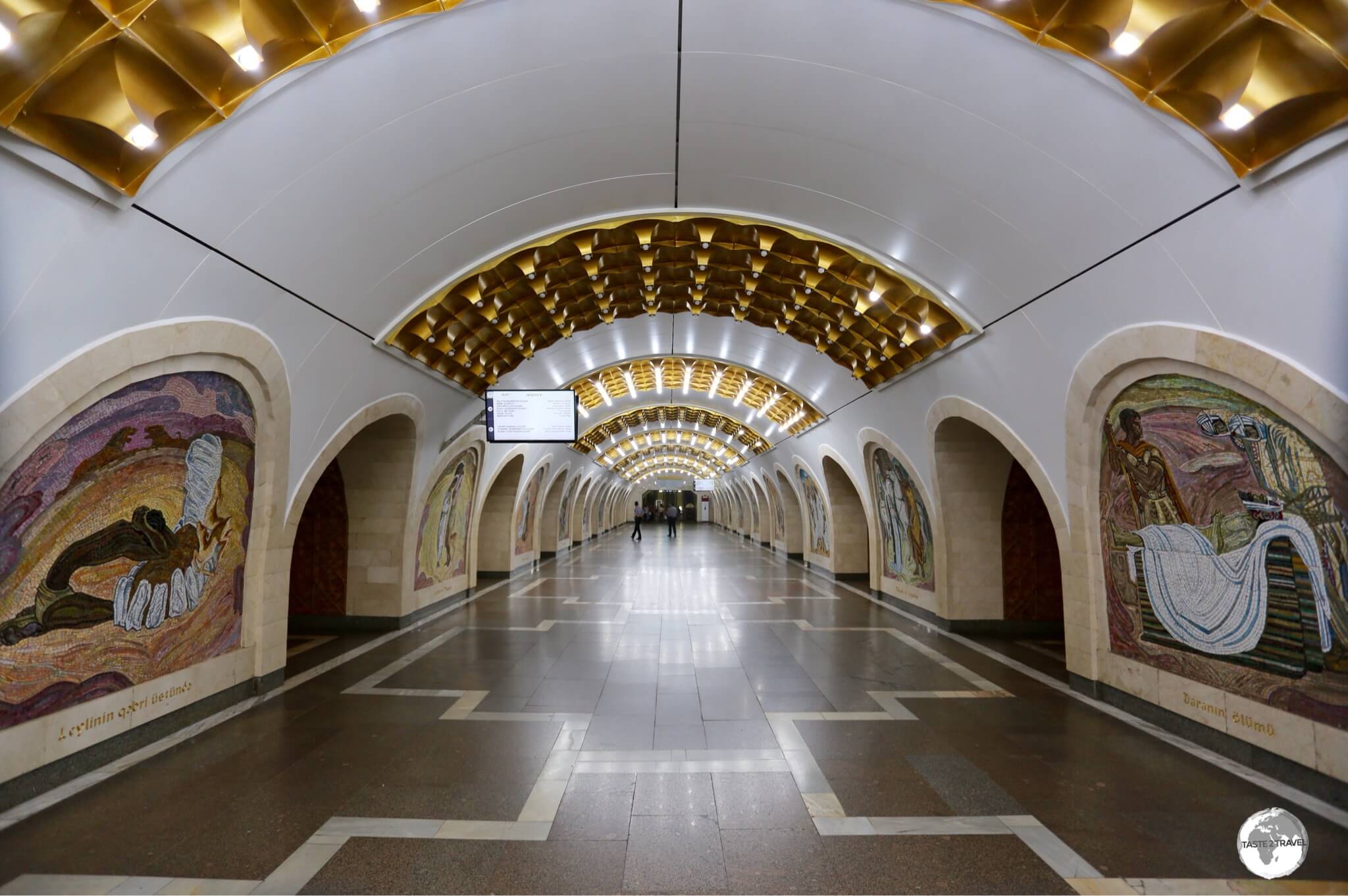
Tile mosaics line the walls of Nizami Metro Station.
One of the most beautiful stations on the system is Nizami metro station, which is named after the great Azerbaijani poet and philosopher Nizami Ganjavi. The station is decorated with mosaic panels which feature subjects from his works.
Public Buses
Buses, which are operated by Baku bus, are the most used form of public transport in the capital. In order to ride any of the buses, you’ll first need to purchase a stored-value BakuCard which costs 2 AZN (USD$1.17), which is non-refundable. A single journey costs 0.30 AZN (USD$0.17).
Inter-city buses depart from the Baku International Bus station, which is known as the Avtovaghzal. If you don’t wish to wait for a bus, you’ll find plenty of, faster, shared taxis at the entrance to the station.
Taxi

Known locally as ‘Eggplants’, the streets of Baku are home to a fleet of London taxis which are all painted in ‘Eggplant’ purple.
If you’re a Londoner feeling homesick in Baku, you only need to hail a cab! The Baku Taxi fleet is comprised of Eggplant-coloured London cabs which were originally ordered by the government when the country hosted the Euro-vision song contest in 2012. The colour choice apparently came direct from the president and the cabs are commonly referred to as ‘eggplants’ by the locals.

A London taxi in Baku, where they are branded as “Baku Taxi”.
The initial order was for 1000 cabs, which were to replace an ageing fleet of Lada taxis, but this number has since grown, with ‘eggplants’ now whizzing everywhere around the capital.

Unlike their London counterparts, Baku Taxis can be hired for off-road adventures.
While London taxis would never dare venture off-road, I saw at least one Baku taxi driving customers along the remote and rough, gravel road to the Mud Volcanoes, which are located 50 km south of the capital.
Shared Taxis
If you don’t have your own transport, the fastest and most convenient way to travel around Azerbaijan is with a shared taxi. If you’re travelling to any of the borders, shared taxis are the way to go.
Taxis leave frequently, once all places have been filled, from outside the International Bus station in Baku. Drivers will often inflate prices for tourists (or encourage you to take a private hire by purchasing all 4 places) so it’s best to confirm the correct price in advance from someone other than the driver.
Shared taxi rates are very reasonable with the six-hour journey from Baku to the Georgian border (“Red Bridge” border crossing) costing me 40 AZN (USD$23). The one-hour taxi ride from the Georgian side of the border into Tbilisi cost me US$20 for a private hire. I completed the 570 km journey from Baku to Tbilisi in 8 hours (which included an hour at the border).
Rental Car

And the award for “Most Speed Cameras in the world” goes to…. Azerbaijan!
While other countries (e.g. Brazil) are much larger than Azerbaijan and have way more cameras – for a small country, Azerbaijan is swamped with speed cameras.
I would estimate that, based on per kilometre travelled, Azerbaijan has more speed cameras than any other country in the world – they are everywhere.
As the government builds newer, faster highways, it is also installing speed cameras, on average, every 2 km, although sometimes they are just 1 km apart. Often you can see from one camera to the next!
The cameras are installed so that they are focused on the road immediately in front of the camera – rather than a longer field of focus. This has led to locals adopting a driving rhythm of speeding up between cameras then slowing down. Most cameras are mounted on a high stand in the middle of the highway, so they are easy to spot in advance.
It’s fair to assume that, if you spend any amount of time driving on the highways of Azerbaijan, you will be photographed.

Off-roading in my rental car in Azerbaijan.
I am a fan of rental cars! They allow you to maximise and prioritise your time in a country. I rented a car through Hertz Baku, which cost me USD$28 per day.
I would highly recommend Hertz who allow you to pick up and return their cars at any of their three locations in Baku, without incurring any silly ‘one-way rental’ fees.
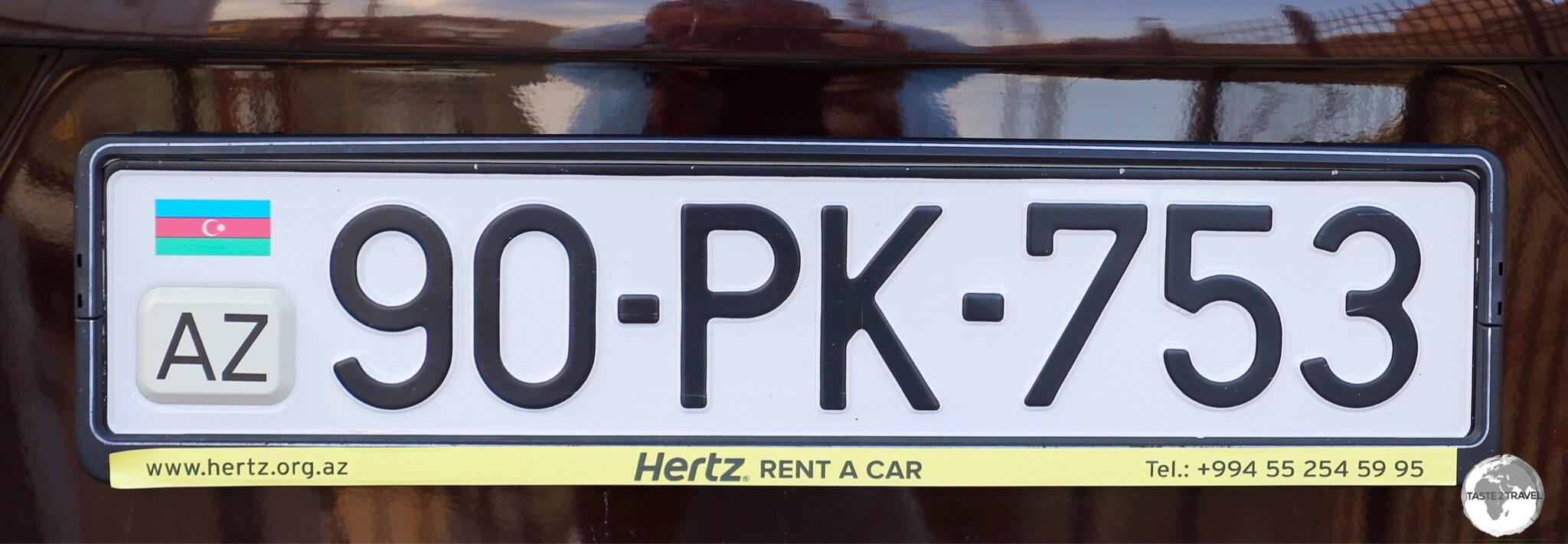
The license plate on my rental car.
The government is currently busy, spending some of their oil revenue, on building excellent 4-lane highways throughout the country so journey times are being reduced, however many regions are still a long way from seeing any of the new infrastructure.
That’s the end of my Azerbaijan Travel Guide.
Safe Travels!
Darren
Follow me on Instagram:
[instagram-feed feed=1]
Further Reading
Other travel reports from the Central Asia region:
Additional blogs, articles and information on Azerbaijan are available on the Indy Guide website.
Azerbaijan Travel Guide Azerbaijan Travel Guide Azerbaijan Travel Guide Azerbaijan Travel Guide Azerbaijan Travel Guide
Azerbaijan Travel Guide Azerbaijan Travel Guide Azerbaijan Travel Guide Azerbaijan Travel Guide Azerbaijan Travel Guide
Azerbaijan Travel Guide Azerbaijan Travel Guide Azerbaijan Travel Guide Azerbaijan Travel Guide Azerbaijan Travel Guide
Azerbaijan Travel Guide Azerbaijan Travel Guide Azerbaijan Travel Guide Azerbaijan Travel Guide Azerbaijan Travel Guide
Azerbaijan Travel Guide Azerbaijan Travel Guide Azerbaijan Travel Guide Azerbaijan Travel Guide Azerbaijan Travel Guide
Azerbaijan Travel Guide Azerbaijan Travel Guide
Author: Darren McLean
Darren McLean is an Australian, full-time, digital nomad who has spent 37 years on a slow meander around the globe, visiting all seven continents, 192/ 193 UN countries and 245/ 251 UN+ countries and territories.
He founded taste2travel to pique one’s curiosity and inspire wanderlust.







